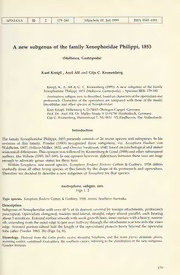
A new subgenus of the family Xenophoridae Philippi, 1853 (Mollusca, Gastropoda) PDF
Preview A new subgenus of the family Xenophoridae Philippi, 1853 (Mollusca, Gastropoda)
SPIXIANA 179-180 München, 01. Juli 1999 ISSN 0341-8391 A new subgenus of the family Xenophoridae Philippi, 1853 (Mollusca, Gastropoda) Kurt Kreipl , Axel Alf and Gijs C. Kronenberg Kreipl, K, A. Alf & G. C. Kronenberg (1999): A new subgenus of the family Xenophoridae Philippi, 1853 (Mollusca, Gastropoda). 4 Spixiana 22/2: 179-180 Austrophora, subgen. nov. is described, based on characters of the operculum and protoconch. Characters of the operculum are compared with those of the family Strombidae and other species of Xenophoridae. Kurt Kreipl, Höhenweg 6, D-74613 Öhringen-Cappel, Germany. Prof. Dr. Axel Alf, Dr. Müller Straße 9, D-91746 Weidenbach, Germany. Gijs C. Kronenberg, Havenstraat 7, NL-5611 VE-Eindhoven, The Netherlands. Introduction The family Xenophoridae Philippi, 1853 presently consists of 26 recent species and subspecies. In his revision of this family, Ponder (1983) recognized three subgenera, viz. Xenophora Fischer von Waldheim, 1807, Stellaria Möller, 1832, and Onustus Swainson, 1840, based on conchological and minor anatomical differences. This opinion was followed by Kronenberg & Goud (1988) and other subsequent authors, like Wilson (1993: 167-169). In our opinion however, differences between these taxa are large enough to advocate genus status for these taxa. Within Xenophora, one recent species, Xenophora flindersi flindersi Cotton & Godfrey, 1938 differs markedly from all other living species of this family by the shape of its protoconch and operculum. Therefore we decided to describe a new subgenus of Xenophora for that species. Austrophora, subgen. nov. Figs 1,2 Type species. Xenophora flindersi Cotton & Godfrey, 1938, recent, Southern Australia. Description Subgenus of Xenophoridae with over 60 % of its dorsum covered by foreign attachments, protoconch paucispiral. Operculum elongated, nucleus mid-lateral, straight, edges almost parallel, each bearing about 5 serrations. External surface smooth with weak growth lines, inner surface with a heavy, narrow rib, extending from the outer edge to just over halfway through the attachment scar towards the inner edge. Serrated portion (about half the length of the operculum) projects freely beyond the opercular lobe (after Ponder 1983: 26) (Figs la, b). Etymology. Derived from the Latin prefix austro, meaning Southern, and the noun phorus (feminin: phora), meaning carrier, combined Austrophora, the southern carrier, referring to the distribution of the new subgenus. Gender feminin. 179 2a Fig. 1. Xenophora (Austrophora) flindersi flindersi Cotton & Godfrey. la. Operculum, external surface. 1b. Operculum, internal surface. Fig. 2. Typical Xenophora s.str. (slightly generalized). 2a. Operculum, external surface. 2b. Operculum, inter- nal surface. Scale: 10 mm. Discussion Austrophora, subgen. nov. differs from Xenophora s.str. by its protoconch and operculum. Xenophora s. str. has a multispiral protoconch. The operculum of Austrophora, subgen. nov. resembles the operculum of Strombidae. Within Strombidae however, the operculum is sickle-shaped, and, if serrated, only serrated at one of the edges. The opercula of all other Xenophoridae show a fairly consistent pattern with relatively little variation. They usually are subtriangular to suboval with smooth edges (the outer edge usually being worn away and rather ragged), with a nucleus near the outer edge. The external surface is typically rather smooth, with concentric growth lines and often microscopic radial scratches. The inner surface has an attachment scar and a non-attached area. The attachment scar occupies about half the inner surface and is usually kidney-shaped. The central area is deposited on top of the rest of the material of which the attachment scar is composed and projects into the attchment scar from its outer edge. The central area is laid down as a layer of radial units on top of the attachment scar which gives it aradially striate appearance (after Ponder 1983: 5). (Figs 2a-2b). The only other known taxon of this new subgenus is Xenophora flindersi ludbrookae Ponder, 1983, a fossil from the Lower Pleistocene and possible Upper Pliocene of south Western Australia. It also shows a paucispiral protoconch, and is regarded as the direct ancestor of the recent species. Acknowledgements We want to thank Miss Dora Jägle, Öhringen, Germany, for doing the line drawings of the opercula. References Kronenberg, G. C. & J. Goud 1988. Xenophoridae 4 een overzicht van alle recent voorkomende soorten. 4 Vita Marina 35: 457-494. Sect. buikpotigen. Ponder, W. F. 1983. Xenophoridae of the World. 4 Australian Mus. Mem. 17: 1-126 Wilson, B. 1993. Australian Marine Shells 1: 1-408. Kallaroo, W.A., Australia. 180
